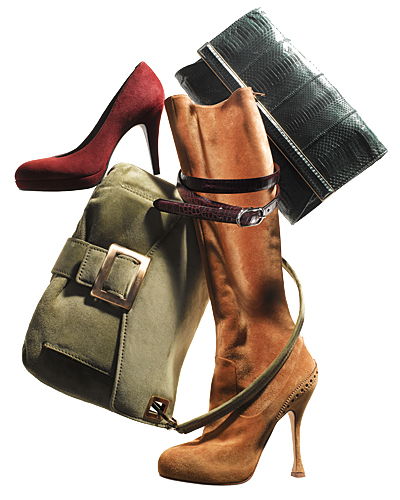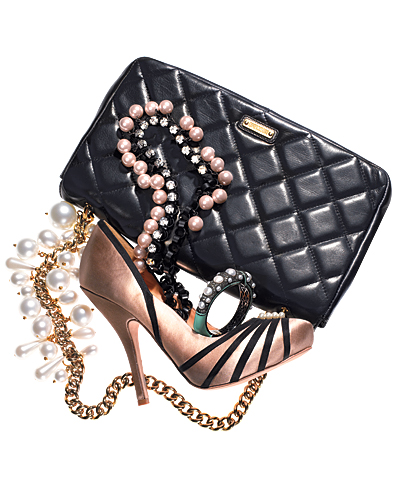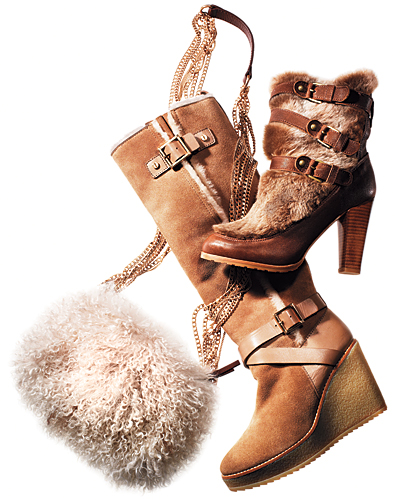Search This Blog
Tuesday, February 15, 2011
Tuesday, February 8, 2011
ტრენდები საშემოდგომო აქსესუარებში
1. ფერები – ინსტაილი გვირჩევს რომ “გავშემოდგომისფერდეთ”
დასრულდა ჭყეტელა ფერების სეზონი, აირჩიეთ ტანსაცმელი, ფეხსაცმელი და აქსესუარები შემოდგომის ფერებში
 2. მარგალიტი – სეზონის ტრენდია, აუცილებლად ჩართეთ ის თქვენს აუტფიტში. ოღონდ ეს იმას არ ნიშნავს რომ ხვალიდან გარეთ გავიდე და ყველას მარგალიტი გეკეთოთ, ყველაფერს მოხდენა და შეთავსება სჭირდება. ყველას არ მოუხდება ეს დეტალი და არც სცადოთ
2. მარგალიტი – სეზონის ტრენდია, აუცილებლად ჩართეთ ის თქვენს აუტფიტში. ოღონდ ეს იმას არ ნიშნავს რომ ხვალიდან გარეთ გავიდე და ყველას მარგალიტი გეკეთოთ, ყველაფერს მოხდენა და შეთავსება სჭირდება. ყველას არ მოუხდება ეს დეტალი და არც სცადოთ  3. გაამსხვილეთ – გააბოლდეთ შტრიხები
3. გაამსხვილეთ – გააბოლდეთ შტრიხებიმინიმალისტური შტრიხები რომლებიც აქამდე დომინირებდა, მაქსიმალურად იცვლება დაცილებით უფრო უხეში და პრიალა დეტალებით.

4. ჩათბუნულ – კომფორტული
წინ ცივი ზამთარი მოდის, რაც თავისთავად გულისხმობს ტანსაცმლის არჩევია გაძნელებას, ეს არ მინდა გავიყინები, ამას ვერ ჩავიცმევ შემცივდება- პერიოდი.
თუმცა დიზაინერები არც ცივ ზამთარს ერიდებიან და გთავაზობენ ჩათბუნულ პალტოებს, ჩექმებს, ქუდებს და ჩანთებსაც კი

5. შტრიხები
ნაზი ქსოვილი, რომელიც ეკვრება თქვენს სამოსს თუ აქსესუარს მოდურს და თანამედროვეს ხდის მათ

6. Military
გაიხარეთ ვისაც გიყვართ მილიტარი დეტალები და ქსოვილები. მე პირადად სასტიკად არ მიყვარს  ამ შემოდგომაზე ის მოდაშია …
ამ შემოდგომაზე ის მოდაშია …
Monday, February 7, 2011
როგორი გოგონები მოსწონს "მისტერ საქართველოს"
რატომღაც საქართველოში მოდელ მამაკაცებს ყველა თუ არა, საზოგადოების ნაწილი მაინც კარგი თვალით არ უყურებს. თავის დროზე ჩატარებულ "მისტერ საქართველოს" კონკურსსაც გამოუჩდნენ :ოპონენტები". 19 წლის გიორგი ობელაძე (რომელიც სამოდელო სფეროში "მისტერ საქართველოს" კონკურსში გამარჯვების შემდეგ ჩაერთო), როცა საჭიროა, მოდელის პროფესიას სერიოზულად ეკიდება, ჩვენებებში მონაწილეობს. ის შინიდან მოუწესრიგებელი არ გადის-სურს, "მისტერ საქარტველოს" ტიტული გაამართლოს.



_"მისტერ საქართველოდ" ყოფნა ჩემთვის დიდი პასუხისმგებლობაა . მნიშვნელოვანია როგორ მოვიქცევი, რადგან ჩემს უკან მთელი საქართველო დგას. ეს, ცოტა არ იყოს რთულია" ხალხში ეჭვები რომ არ გაჩნდეს, შინიდან მოუწესრიგებელი ვერ გავალ. მინდა, იმ ტიტულს ვიმსახურებდე , რომელიც მაქვს. გარდა ამისა, სასიამოვნო და საამაყოა, როცა მაგალითად, ქუჩაში მცნობენ.
_ხალხისგან არაკეთილგანწყობილი დამოკიდებულება თუ გიგრძვნია?
_არა
_არასოდეს?
_ყოველ შემთხვევაში, იმ ხალხისგან არა ვინც ჩემს გარშემოა: მეგობრები, ნათესავები, ძმაკაცები, დაქალები.... იმის გამო , რომ მისტერ საქართველოს კონკურსში ვმონაწილეობდი, მათგან უარყოფითი დამოკიდებულება არ მიგრძვნია.
_გოგონები შენს მოდელობას როგორ აღიქვამენ?
_ჩემი აზრით, ეს ფაქტი ყველა ნორმალურმა ადამიანმა ჩვეულებრივად უნდა აღიქვს. მოდელობაც ერთ-ერთი პროფესიაა. სხვის საქმიაანობას ყველამ პატივი უნდა სცეს, მაგრამ რამდენი ადამიანიცაა, იმდენი აზრია ქვეყანაზე. მიმაჩნია, რომ მოდელი მამაკაცი ვაჟკაცური, სიმპათიური, არტისტული უნდა იყოს. ალბათ, ქართული მენტალიტეტის გამო, ხალხში მუსირებს აზრი, რომ მოდელი ბიჭები არამამაკაცურები არიან. "მისტერ საქართველოში" ძალიან კარგი, საინტერესო კონკურსანტები იყვნენ და მათზე ვინმემ აუგი რომ თქვას, არ ვაპატიებ (იცინის)! ვინც მიცნობს, ცუდის თქმას ვერ შემკადრებს, რადგან იციან, როგორი პიროვნება ვარ.
_მოდელის პროფესიას სერიოზულად ეკიდები, თუ ეს საქმე შენთვის უბრალოდ, ჰობია?
_ვერ ვიტყვი, რომ ჰობია, მაგრამ ვერც იმას ვიტყვი, რომ პროფესიაა. როცა საჭიროა, ამ საქმეს სერიოზულად ვეკიდები. ჩემს მომავალ პროფესიას რაც შეეხება, "ჯავახიშვილში", ბიზნესის ადმინისტრირების ფაკულტეტზე ვსწავლობ. ასე რომ მოდელობა მეორადი პროფესიაა.
_"მისტერ საქართველოს" კონკურსში მონაწილეობამდე მოდელი იყავი?

_არა. კონკურსის შესახებ ტელეეკრანიდან გავიგე. თავდაპირველად მონაწილეობა არ მინდოდა. განა იმიტომ რომ ეს ცუდია, უბრალოდ სურვილი არ მქონდა, მაგრამ მეგობრების დაჟინებული თხოვნით (სხვათა შორის ოჯახისაც), რეგისტრაცია გავიარე.
_გამარჯვებას არ ელოდი?
_სიმართლე გითხრათ-არა, ერთად-ერთი სურვილი მქონდა საუკეთესო ხუთელთა სიაში ჩემი საცელიც ყოფლიყო.
_წლევანდელი "მის საქართველო" თუ მოგწონს?
_კი, ცირა სუქნიძე ძალიან ლამაზი დამეგობრული გოგონაა.
_ზოგადად ქართველ მოდელ გოგონებზე რას ფიქრობ?
_ბევრი კარგი გარეგნობის გოგონა გვყავს, მაგრამ უმეტესობა დასახვეწია: მორცხვები არიან, ხალხში იბენევიან... ამას თუ დაძლევენ, ბევრს აქვს შანსი, რომ წარმატებული მოდელი გახდეს.
_გიორგი, შენს ყურადღებას როგორი გოგონები იპყრობენ?
_უბრალო გოგონები."ფუტლარებს" ვერ ვიტან (იცინის) შეიძლება გოგონა გარეგნულად მომხიბვლელი იყოს, მაგრამ თვალებში რომ შეხედავ მიხვდები - საინტერესო არაა...
ჟურნალი გზა
ავტორი:ეთო ყორღანაშვილი
Saturday, February 5, 2011
Couture beginnings
The first fashion designer who was not merely a dressmaker was Charles Frederick Worth (1826–1895). Before the former draper set up his maison de couture(fashion house) in Paris, clothing design and creation was handled by largely anonymous seamstresses, and high fashion descended from styles worn at royal courts. Worth's success was such that he was able to dictate to his customers what they should wear, instead of following their lead as earlier dressmakers had done.
It was during this period that many design houses began to hire artists to sketch or paint designs for garments. The images alone could be presented to clients much more cheaply than by producing an actual sample garment in the workroom. If the client liked the design, they ordered it and the resulting garment made money for the house. Thus, the tradition of designers sketching out garment designs instead of presenting completed garments on models to customers began as an economy.
[edit]
Wednesday, February 2, 2011
Early twentieth century
Throughout the early 20th century, practically all high fashion originated in Paris and to a lesser extent London. Fashion magazines from other countries sent editors to the Paris fashion shows. Department stores sent buyers to the Paris shows, where they purchased garments to copy (and openly stole the style lines and trim details of others). Both made-to-measure salons and ready-to-wear departments featured the latest Paris trends, adapted to the stores' assumptions about the lifestyles and pocket books of their targeted customers.
At this time in fashion history the division between haute couture and ready-to-wear was not sharply defined. The two separate modes of production were still far from being competitors, and, indeed, they often co-existed in houses where the seamstresses moved freely between made-to-measure and ready-made.
Around the start of the 20th century fashion style magazines began to include photographs and became even more influential than in the future. In cities throughout the world these magazines were greatly sought-after and had a profound effect on public taste. Talented illustrators - among them Paul Iribe, Georges Lepape, Erté, and George Barbier - drew exquisite fashion plates for these publications, which covered the most recent developments in fashion and beauty. Perhaps the most famous of these magazines was La Gazette du bon ton which was founded in 1912 by Lucien Vogel and regularly published until 1925 (with the exception of the war years).
[edit]1900s
The outfits worn by the fashionable women of the 'Belle Époque' (as this era was called by the French) were strikingly similar to those worn in the heyday of the fashion pioneer Charles Worth. By the end of the 19th-century, the horizons of the fashion industry had generally broadened, partly due to the more stable and independent lifestyle many well-off women were beginning to adopt and the practical clothes they demanded. However, the fashions of the La Belle Époque still retained the elaborate, upholstered, hourglass-shaped style of the 19th century. As of yet, no fashionable lady could (or would) dress or undress herself without the assistance of a third party. The constant need for radical change, which is now essential for the survival of fashion within the present system, was still literally unthinkable. The use of different trimmings were all that distinguished one season from the other.
Conspicuous waste and conspicuous consumption defined the fashions of the decade and the outfits of the couturiers of the time were incredibly extravagant, elaborate, ornate, and painstakingly made. The curvaceous S-Bend silhouette dominated fashion up until around 1908. The S~Bend corset was very tightly laced at the waist which forced the hips back and the drooping mono bosom was thrust forward in a pouter pigeon effect creating an S shape. Toward the end of the decade the fashionable silhouette gradually became somewhat more straight and slim, partly due to Paul Poiret's high-waisted, shorter-skirted Directoire line of clothes.
The Maison Redfern was the first fashion house to offer women a tailored suit based directly on its male counterpart and the extremely practical and soberly elegant garment soon became an indispensable part of the wardrobe of any well-dressed woman. Another indispensable part of the outfit of the well-dressed woman was the designer hat. Fashionable hats at the time were either tiny little confections that perched on top of the head, or large and wide brimmed, trimmed with ribbons, flowers, and even feathers. Caroline Reboux, Legroux, and E. Lewis were the most sought-after names of the time. Parasols were still used as decorative accessories and in the summer they dripped with lace and added to the overall elaborate prettiness.
[edit]1910s
During the early years of the 1910s the fashionable silhouette became much more lithe, fluid and soft than in the 20th century. When the Ballets Russes performedScheherazade in Paris in 1910, a craze for Orientalism ensued. The couturier Paul Poiret was one of the first designers to translate this vogue into the fashion world. Poiret's clients were at once transformed into harem girls in flowing pantaloons, turbans, and vivid colors and geishas in exotic kimono. Paul Poiret also devised the first outfit which women could put on without the help of a maid. The Art Deco movement began to emerge at this time and its influence was evident in the designs of many couturiers of the time. Simple felt hats, turbans, and clouds of tulle replaced the styles of headgear popular in the 20th century. It is also notable that the first real fashion shows were organized during this period in time, by the first female couturier, Jeanne Paquin, who was also the first Parisian couturier to open foreign branches in London, Buenos Aires, and Madrid.
Two of the most influential fashion designers of the time were Jacques Doucet and Mariano Fortuny. The French designer Jacques Doucet excelled in superimposing pastel colors and his elaborate gossamery dresses suggested the Impressionist shimmers of reflected light. His distinguished customers never lost a taste for his fluid lines and flimsy, diaphanous materials. While obeying imperatives that left little to the imagination of the couturier, Doucet was nonetheless a designer of immense taste and discrimination, a role many have tried since, but rarely with Doucet's level of success.
The Venice-based designer Mariano Fortuny y Madrazo was a curious figure, with very few parallels in any age. For his dress designs he conceived a special pleating process and new dyeing techniques. He gave the name Delphos to his long clinging sheath dresses that undulated with color. Each garment was made of a single piece of the finest silk, its unique color acquired by repeated immersions in dyes whose shades were suggestive of moonlight or of the watery reflections of the Venetian lagoon. Breton straw, Mexican cochineal, and indigo from the Far East were among the ingredients that Fortuny used. Among his many devotees were Eleanora Duse, Isadora Duncan, Cleo de Merode, the Marchesa Casati, Emilienne d'Alençon, and Liane de Pougy.
Changes in dress during World War I were dictated more by necessity than fashion. As more and more women were forced to work, they demanded clothes that were better suited to their new activities. Social events had to be postponed in favor of more pressing engagements and the need to mourn the increasing numbers of dead, visits to the wounded, and the general gravity of the time meant that darker colors became the norm. A new monochrome look emerged that was unfamiliar to young women in comfortable circumstances. By 1915 fashionable skirts had risen above the ankle and then later to mid-calf.
[edit]
Subscribe to:
Posts (Atom)


